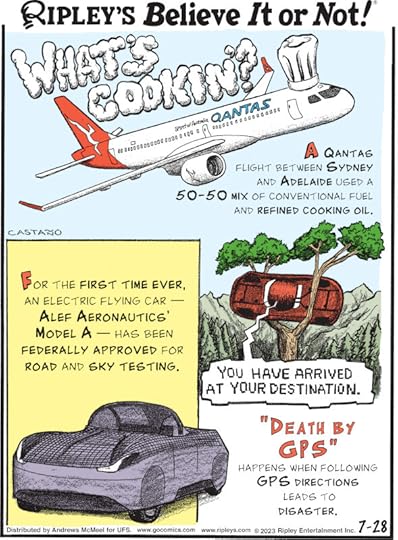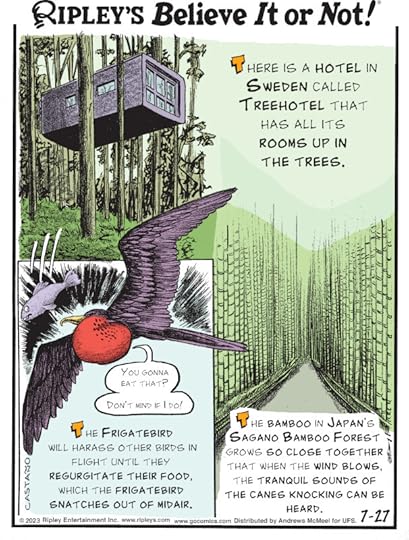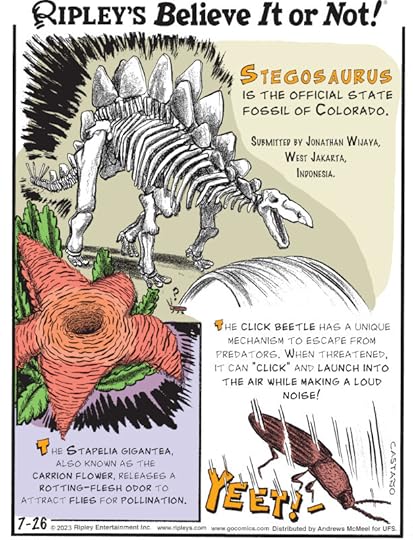Ripley Entertainment Inc.'s Blog, page 15
July 28, 2023
Up Close & Peculiar: Diving Into All Things Dinosaur
Featured in Ripley's Believe It or Not!

Today: Dinosaurs
Hello everyone! Today is a little different because we are taking a look at a huge piece! This is a section, mostly the tail and part of the spine, of a hadrosaurid, or a duck-billed dinosaur. I genuinely cannot believe this is a real thing that I’m looking at. If just the tail is this big, I cannot even imagine how big the whole dino was!
As if standing in front of a twenty-foot dinosaur tail wasn’t cool enough, what’s even cooler about this piece is that there is actually mummified skin and tendons on this thing, as you can see here! Finding soft tissue preserved like this is unbelievably rare.
We can tell a little bit more about this dino’s story by looking at what paleontologists believe are bite marks or scars, which tell us that the tail was being used defensively, or even that a T-Rex might have bitten it off in the heat of a battle!
Staying in the world of dinosaurs, I also have with me these dino footprints! We don’t know exactly what type of dinosaur left these tracks, but I feel like these kind of look like prehistoric chicken feet, except this chicken would definitely eat me for dinner instead of the other way around!
Would you have liked to have met these dinosaurs? Let us know in the comments and I’ll see you next time!
EXPLORE THE ODD IN PERSON! Discover hundreds of strange and unusual artifacts and get hands-on with unbelievable interactives when you visit a Ripley’s Odditorium!Source: Up Close & Peculiar: Diving Into All Things Dinosaur
Astronomers Discovered a Skyscraper-Sized Asteroid Zoomed Past Earth
Featured in Ripley's Believe It or Not!

Earlier this month, astronomers discovered that an asteroid the size of a skyscraper flew quite close to Earth—but they did not know about it until two days after the incident occurred. The asteroid, named 2023 NT1, zoomed by closer to Earth than to the moon on July 13 at a speed of approximately 53,00 mph, according to Live Science. The space rock measured 200-feet wide and was approximately the size of a 20-story building.
Grab Your SunglassesThe reason why scientists were unaware of the passing is because the asteroid traveled to Earth from a direction with a lot of sun glare. This made the asteroid difficult to see in telescopes. It was not until July 15 when the Asteroid Terrestrial-impact Last Alert System (ATLAS) in South Africa spotted the space rock leaving Earth’s vicinity. This system was created to track asteroids to prepare for possible impacts but was a little late to the party. ATLAS wasn’t the only system that failed to spot 2023 NT1; other telescopes around the world belatedly recorded the asteroid’s path as well, according to the International Astronomical Union’s Minor Planet Center.
The good news is that this asteroid is not large enough to be classified as a potentially hazardous object. Astronomers have determined that there is no imminent risk of an impact from 2023 NT1 in the next 10 years. What is even more comforting is that Earth should be safe from extinction-type asteroids for at least 1,000 years, according to experts.

Chelyabinsk meteor on February 15, 2013. Credit: Aleksandr Ivanov Via Wikimedia Commons (CC BY-SA 3.0).
Unfortunately, near-Earth asteroids can be impossible to see in blind spots caused by the sun’s glare. This isn’t even the first time it has happened! Tragically, 1,500 people were injured when a 59-long-foot asteroid exploded over Chelyabinsk, Russia in 2013. Buildings and glass were damaged and shattered as a result, but luckily no one was killed. Dashboard cameras famously captured footage of the event.
Keeping An Eye on the SkyExperts regularly keep tabs on over 31,000 known asteroids in Earth’s vicinity; however, scientists understand that solar blind spots are potentially problematic. As a result, the European Space Agency is building a satellite through its NEOMIR mission to orbit Earth and the sun in order to see big asteroids that are hard to spot due to sun glare. The satellite is expected to be operational in 2030.
While perhaps not quite as impactful as the NEOMIR mission but worth mentioning nonetheless, a classic toy has helped take care of astronauts–and that toy is Barbie. Barbie is not only a box office success; she is also a rockstar when it comes to helping space travelers.
Scientists showered Barbie wearing an astronaut suit with a moondust substitute and then blasted her with liquid nitrogen. Since it is illegal to buy and sell actual moondust, researchers improvised. Using volcanic ash from Mount Saint Helens researchers were able to remove 98 percent of the matter from the suit! It is important to remove moondust from spacesuits because it is toxic to human cells. Barbie survived the ordeal, and her space suit was only minimally damaged. The experiment provided a big improvement over the brush and dust system traditionally used to remove moondust.
If you are a space junkie, be sure to check out the original footage from Apollo 11’s successful landing in 1969 at the Out of This World gallery at Ripley’s Believe It or Not! Orlando.
By Noelle Talmon, contributor for Ripleys.com
EXPLORE THE ODD IN PERSON! Discover hundreds of strange and unusual artifacts and get hands-on with unbelievable interactives when you visit a Ripley’s Odditorium!Source: Astronomers Discovered a Skyscraper-Sized Asteroid Zoomed Past Earth
CARTOON 07-28-2023
July 27, 2023
Fordlandia: The Failure Of Henry Ford’s Utopian City In The Amazon
Featured in Ripley's Believe It or Not!

Once upon a time, deep in the heart of the Amazon Rainforest, a transplanted slice of the American dream sprung to life. This is the almost forgotten story of Fordlandia.
Journey to the heart of the AmazonIt was the late 1920s, and automotive giant Henry Ford was looking for a dependable, affordable source of rubber — suddenly a precious material for the booming automobile industry.
With the British completely controlling the rubber production coming out of Asia, Ford started to look abroad for his own supply. He eventually landed his eyes on a remote area of Brazil’s Amazon Rainforest.

Portrait of Henry Ford (1919). Credit: Wikimedia Commons.
A full day’s journey by boat from the nearest city, the Amazon was still the wild, untamed frontier. It was exactly there that an American industrial dream began to take root. Fordlandia, as it would eventually be called, was a huge gamble, but Ford was up for the challenge.
Jungle all the way: A rubber kingdom risesFord’s ambition was as vast as the land he acquired in 1928. He didn’t just purchased 2.5 million acres of land from the Brazilian government, but he also set out to build an entirely self-sufficient plantation where the workers would live, a sort of prototypical American community with picket fences, Cape Cod-style houses, and streets lined up with light posts and bright red fire hydrants.
Fordlandia, as Ford envisioned it, would have swimming pools, a tennis court, and a golf course, but also no alcohol and a strict diet of “brown rice and whole-wheat bread and canned peaches and oatmeal.” There were even mandatory weekend activities such as square-dancing and poetry readings.
The American dream meets Amazon realityFord’s American dream didn’t mesh well with Amazon’s reality and the project experienced problems right from the start. The native workers, not used to a regimented, factory-style routine, soon started to rebel.
The first complaint was the food, far removed from the traditional Brazilian fare, as well as the cafeteria-style servings that didn’t match the local way of eating around the dinner table. The prohibition of sale and consumption of alcohol was another point of contention. This issue was soon solved by the rise of tiny villages nearby (dubbed the “Island of Innocence”) offering plenty of cachaça—a popular local spirit.

Aerial view of Fordlandia in 1934. Credit: Wikimedia Commons.
Workers soon dubbed Fordlandia the “Inferno verde” or “Green Hell” because the combination of bad food, malaria from poor mosquito management (a big complaint was that beds didn’t have mosquito nets), and deadly snakes meant that many of the residents were constantly sick.
Riots, rumbles and a resounding retreat: The swan song of Ford’s dreamThen there was the issue of the rubber trees themselves. Although rubber trees are native to the Amazon, in the wild they grow sporadically and over large spaces. A very different setup to the highly packed, orderly rows of trees that Ford’s agricultural engineers used. This unnatural planting provided an easy pathway for tree blight and pests to spread. This not only led to flies invading Fordlandia but also devastated the trees.
By 1930, worker discontent had grown into outright rebellion. Workers rioted, destroying property and forcing the Brazilian military to step in to quell the uprising. It was becoming apparent that Fordlandia was not going to be the rubber-producing utopia that Ford had imagined.
For the next few years, Ford tried everything, including bringing a botanist to figure out why the trees weren’t thriving. Turned out the damp, hilly terrain was the perfect environment for the blight to prosper, but not at all the right place for the trees themselves because of poor soil quality.
Undeterred, Ford bought more land with better soil nearby and started again from scratch. By 1942, even the newest branch of his enterprise was producing a mere 750 tons of latex a year — nowhere near the 38,000 tons needed for the investment to be worth it. In the end, “not one drop of latex from Fordlandia ever made it into a Ford car.“
Fordlandia today: A dream rememberedDisaster after disaster struck Fordlandia. A caterpillar and fungus plague, followed by the invention of synthetic rubber, which made rubber trees irrelevant. In 1945, Ford abandoned his dream and sold the land back to the Brazilian government — he had lost over $20 million building his dream, a place he never even had a chance to visit.

Abandoned building with broken windows and the historic water tank tower of Fordlandia.
Today, Fordlandia stands as a relic of the past. The American-style houses, hotel, and water tower have been taken over by nature and bats and other wildlife now inhabit the ruins. While looters eventually stole any equipment left behind, enough buildings were left standing than by the year 2000, people started moving back in.
About 2,000 people live in the former Fordlandia today, a mix of farm workers and poverty-stricken migrants from other parts in Brazil. They survive by growing their own food and supplement their income with government pensions or social welfare payments. Many moved into the American-style bungalows left behind when Fordlandia managers packed up and left.
Fordlandia may not have turned out as Henry Ford planned, but it remains a fascinating example of chasing your dreams, wherever they take you.
By Diana Bocco, contributor for Ripleys.com
EXPLORE THE ODD IN PERSON! Discover hundreds of strange and unusual artifacts and get hands-on with unbelievable interactives when you visit a Ripley’s Odditorium!Source: Fordlandia: The Failure Of Henry Ford’s Utopian City In The Amazon
CARTOON 07-27-2023
July 26, 2023
How Zebra Sharks Are Helping Two Aquariums Save the Species
Featured in Ripley's Believe It or Not!

When you hear the word “shark,” what comes to mind? For many, movies like Jaws, The Meg, or The Shallows feature front and center. Over the years, these blockbusters have entertained audiences while raking in the big bucks. But they’ve also shrouded our perceptions of sharks in terror.
Sharks fall under the larger umbrella of cartilaginous fishes, along with rays, and both have more to fear from humans than humans do from them. Of the thousands of shark and ray species on the planet, about one-third face extinction. The reason? A perfect storm of overfishing and ecosystem collapse.
Fortunately, zebra sharks (Stegostoma tigrinum) are helping researchers develop new conservation strategies. Along the way, scientists have learned about zebra sharks’ ability to reproduce asexually (known as parthenogenesis) and the unique egg-prints (like fingerprints) distinct to each shark mom.
Shark Populations are Quickly DecliningWith more than 70 percent of all shark and ray species in decline, scientists are in a race against time. And the implications of not winning this race could prove devastating. After all, many species of sharks are apex predators. They play a vital role in keeping our oceans healthy, balanced, and functioning properly.
How do we help cartilaginous fish populations rebound? That’s a question Dr. Kady Lyons of Georgia Aquarium and Dr. Jennifer Wyffels of Ripley’s Aquariums decided to find out firsthand. They collaborated with the SAFE Shark and Ray Program, accredited by the Association of Zoos and Aquariums (AZA), to uncover potential answers within zebra shark populations.
How Studying Zebra Sharks Can HelpFunded through an AZA Conservation Grant, Lyons and Wyffels focused on crucial questions related to zebra shark productivity. These questions included:
How many eggs does a female zebra shark lay in a season?Which months are they most productive?How often does asexual reproduction (known as parthenogenesis) occur?When is male zebra shark semen most likely to result in shark babies?How did Lyons and Wyffels gather this data? By enlisting a team of researchers to collect information about 22 females, five males, and 2,410 shark eggs from ten institutions.
They employed various techniques and technologies, including old-fashioned physical exams, ultrasounds, and blood panels. In particular, the ultrasounds allowed the scientists to peek inside zebra sharks’ internal reproductive anatomy. Combined with regular blood tests to monitor hormone levels, researchers gained a more accurate picture of reproductive seasonality in zebra sharks.
Asexual Reproduction: A Not-So-Super PowerHow do things like parthenogenesis fit into the zebra shark reproductive cycle? This phenomenon allows female sharks to reproduce alone, without the input of a male zebra shark. The result? Carbon copies of mom.
View this post on Instagram
A post shared by AZA (@zoos_aquariums)
While you’d think that asexual reproduction represents a miracle process with the potential to save zebra shark populations, think again. Parthenogenesis results in parthenotes.
What’s the problem with parthenotes? Since they are created solely out of the mother’s genetic material, they lack genetic diversity. Think of them as imperfect copies of their female parent. Each copy drastically limits the genetic variety of the species — no bueno for population expansion.
Egg-Prints and Genetic TestingDuring their research, Lyons and Wyffels discovered that parthenogenesis happened at least once for most zebra shark females. But how could they be sure which eggs belonged to which shark? By recording the “egg-print” of each female shark. Like fingerprints, the characteristics of eggs are unique to every laying female.
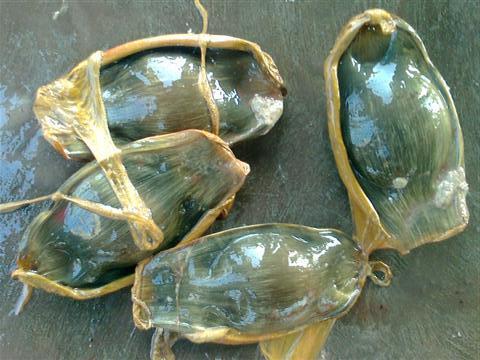
Dr. Kady Lyons of Georgia Aquarium and Dr. Jennifer Wyffels of Ripley’s Aquariums studied hundreds of zebra shark eggs to uncover valuable information that will help with the conservation of the species. Image credit: Akhilesh K.V. / FishBase
This allowed the researchers to identify offspring born in tanks frequented by multiple females. But it didn’t give any indications about which babies were parthenotes. To get to the bottom of this, researchers relied on genetic testing.
The Takeaway: Zebra Shark Reproductive ResearchWhat’s the takeaway regarding the work done by Lyons, Wyffels, and their team? Their data will be used to further zebra shark conservation through the Stegostoma tigrinum Augmentation and Recovery (StAR) Project. Their ultimate goal? Bringing zebra sharks back in abundance to their native waters off the coast of Indonesia.
To achieve this, the data will be used to match male and female sharks. This will help ensure the greatest genetic health and diversity across institutions, nationally and internationally. The eggs these breeding pairs produce will head to Indonesia for hatching and release into protected areas.
Most importantly, by understanding the reproductive cycle of zebra sharks, conservationists can avoid relocating parthenotes to Southeast Asia. It’s an egg-cellent step in the right direction for ocean health and renewal!
Want to catch these beautiful sharks up close and in person? Add Ripley’s Aquarium of Canada to your next travel plans for a jaw-some time!
By Engrid Barnett, contributor for Ripleys.com
EXPLORE THE ODD IN PERSON! Discover hundreds of strange and unusual artifacts and get hands-on with unbelievable interactives when you visit a Ripley’s Odditorium!Source: How Zebra Sharks Are Helping Two Aquariums Save the Species
CARTOON 07-26-2023
July 25, 2023
Dino-Eating Mammals? This Fossil’s Rewriting the Prehistoric Food Chain
Featured in Ripley's Believe It or Not!
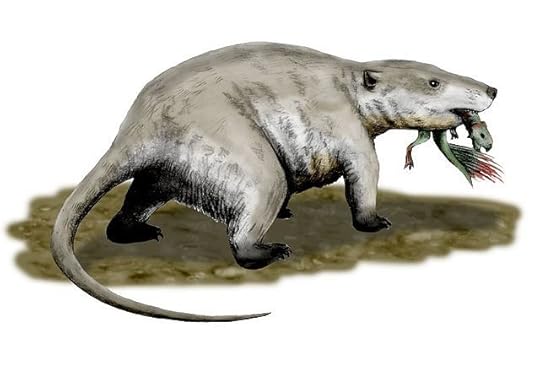
It’s been widely accepted for generations that dinosaurs once ruled the Earth. Movies like the Jurassic Park franchise have bolstered these claims by presenting images of terrifying reptiles capable of unrelenting blood baths. Not surprisingly, humans and other mammals fall squarely at the bottom of the food chain in such flicks.
These depictions echo a long-held sentiment that the first mammals to inhabit the planet ate insects and did everything they could to avoid their reptile counterparts. Their small size helped them go undetected. But a recent fossil find is rewriting everything we know about the Cretaceous period and where mammals ranked in the food chain.
As it turns out, dino-eating mammals were a thing. How common were they? Scientists have yet to work this question out. Nevertheless, one thing’s for sure. The “Circle of Life” wasn’t as clear-cut as we assume.
Frozen in TimeAbout 125 million years ago, a death match between two Cretaceous animals came to a surprising stalemate … mid-bite. That’s when a volcanic flow interrupted their scuffle, burying the two animals in layers of molten lava.
The lava scalded their flesh, killing them instantly. But it also preserved their skeletons, immortalizing the record of their final struggle.
Fast forward to 2012. A Chinese farmer unwittingly stumbled upon the fossilized scene. After turning the find over to officials, it sat in the equivalent of fossil purgatory. After all, cases of forged fossils from this area are nothing new. But once the details of its provenance and authenticity were determined, researchers were in for a shock.
The find passed the sniff test. Studying the authenticated fossil began in earnest, revealing a new side to the coexistence between dinosaurs and mammals.
A One-of-a-Kind FossilTo say the fossil is unprecedented proves an understatement. Jordan Mallon, a paleobiologist with the Canadian Museum of Nature, puts it this way. “I’ve never seen a fossil like this before.”
A new fossil find from the Lujiatun Member of the Lower Cretaceous Yixian Formation of China shows a psittacosaurid dinosaur being attacked by a smaller mammal, making paleontologists rethink what we knew of early food chains. pic.twitter.com/5h7Gir3cFG
— IGN (@IGN) July 24, 2023
What are the implications of this discovery? Genuinely groundbreaking, according to Steve Busatte, a paleontologist at the University of Edinburgh. He explains, “This turns the old story on its head. We’re used to thinking of the Age of Dinosaurs as a time when dinosaurs ruled the world, and the tiny mammals cowered in the shadows.”
Put another way, mammals weren’t merely simpering rodents, slinking around in the background. Some, like the mammal in the fossil, actively hunted dinosaurs.
A Battle to the DeathOf course, this begs the question. What does the fossil show?
It contains the skeletons of two long-extinct animals. The first is Repenomamus robustus, a badger-like mammal comparable in size to a modern-day housecat. The second animal? Psittacosaurus lujiatunensis, a dinosaur with a parrot-like beak that stood around the height of a medium-sized dog.
Despite the size difference, Repenomamus robustus clearly had the upper hand. Yes, Psittacosaurus lujiatunensis was bigger and a dinosaur. But it also had an obvious disadvantage. As an herbivore, it spent much of its time eating plants, not engaging in deadly battles.
Death Is in the DetailsThe postures each skeleton took at the moment of fossilization support this conclusion. For starters, the mammal sits perched atop the reptile.
Its teeth lie buried in the reptile’s ribcage, and its paws grip the dino’s hind leg and jaw. These details indicate the mammal as the obvious aggressor in this prehistoric conflict.
But should we read so much into this strange fossil? After all, it could involve rewriting history as we know it.
Other Fascinating FossilsAs it turns out, this isn’t the first time a mammal fossil has pointed to dinosaur meat as an active part of mammalian diets. In 2005, the American Museum of Natural History in New York revealed a fossil of another Repenomamus robustus with a baby Psittacosaurus in its stomach.
So, it appears there’s history between these two species. With the dinosaur rarely coming out on top. As we stay tuned to discover what else scientists have to say about this discovery, why not explore some other bizarre and unbelievable fossils? One of our faves? This well-preserved mammoth nipple, dating to the Ice Age!
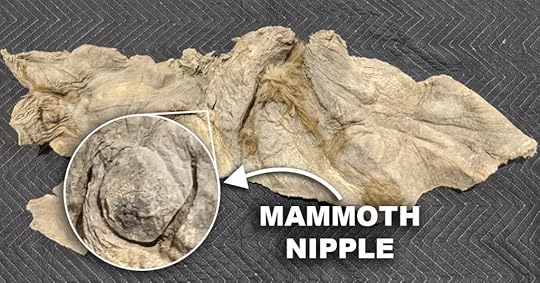
It has provided scientists with new insights into the lives of woolly mammoth moms and their babies. Acquired in Summer of 2022 by Ripley’s, it’s one of many incredible artifacts you can see on display when you visit one of our Odditoriums. Find an attraction near you!
By Engrid Barnett, contributor for Ripleys.com
EXPLORE THE ODD IN PERSON! Discover hundreds of strange and unusual artifacts and get hands-on with unbelievable interactives when you visit a Ripley’s Odditorium!Source: Dino-Eating Mammals? This Fossil’s Rewriting the Prehistoric Food Chain
CARTOON 07-25-2023
July 24, 2023
Up Close & Peculiar: Is Bigfoot More Than A Myth?
Featured in Ripley's Believe It or Not!

Today: Bigfoot
Could Bigfoot be deemed real in our lifetime? Let’s investigate!
Up first, we have an official letter from the FBI in regards to this alleged piece of Bigfoot hair. In 1976, an Oregon man named Peter Byrne wrote the FBI multiple times to request that they test a hair and skin sample that he had found during one of his Bigfoot searches. He wanted the record to be set straight, once and for all. Was Bigfoot was really wandering around the Pacific Northwest?
Now I know Bigfoot seems kinda far-fetched, but consider this. Cryptozoology is the study of creatures only known through anecdotal evidence. Your mind might go straight to unicorns and Nessie, but many animals we know today were once considered cryptids!
Scandinavian folklore warned sailors of the Kraken, however, the creature was revealed to be a giant squid in 1853. We didn’t have footage of a giant squid until 2005! The komodo dragon wasn’t confirmed until 1910, and the gorilla was folklore until 1847. It’s estimated that over 15 million species live on our planet, but only two million are known to scientists.
Listen, I’m not saying that Bigfoot is real but I’m just saying there’s a whole lotta animals crawling around the planet that we don’t know about!
Anyways, back to the letter. In 1976, FBI Assistant Director Jay Cochran Jr. sent a reply back to Byrne saying that he agreed to examine the specimens he sent them. A few months later in 1977, this letter was sent out to Howard Curtus, executive vice president of the Academy of Applied Science in Boston. The Academy had a relationship with Burn’s Bigfoot group. Believe It or Not!, the academy had been the chief sponsor of a search for the Loch Ness monster in Scotland.
As you can see here, Cochran writes that while testing the sample, he “included a study of morphological characteristics such as root structure, medullary structure and cuticle thickness in addition to scale casts.” Unfortunately for the Bigfoot truthers, Cochran ended his letter by concluding that the sample was actually deer hair.
This conclusion isn’t stopping anyone’s Bigfoot search. If you have stepped anywhere near a forest-y area recently, you know every store within a fifty mile radius is selling obscene amounts of Bigfoot merch.
Do you have evidence that Bigfoot exists? DM me personally with your Bigfoot pictures and I’ll let you know if I think it’s legit or not. See you later!
EXPLORE THE ODD IN PERSON! Discover hundreds of strange and unusual artifacts and get hands-on with unbelievable interactives when you visit a Ripley’s Odditorium!Ripley Entertainment Inc.'s Blog
- Ripley Entertainment Inc.'s profile
- 52 followers


